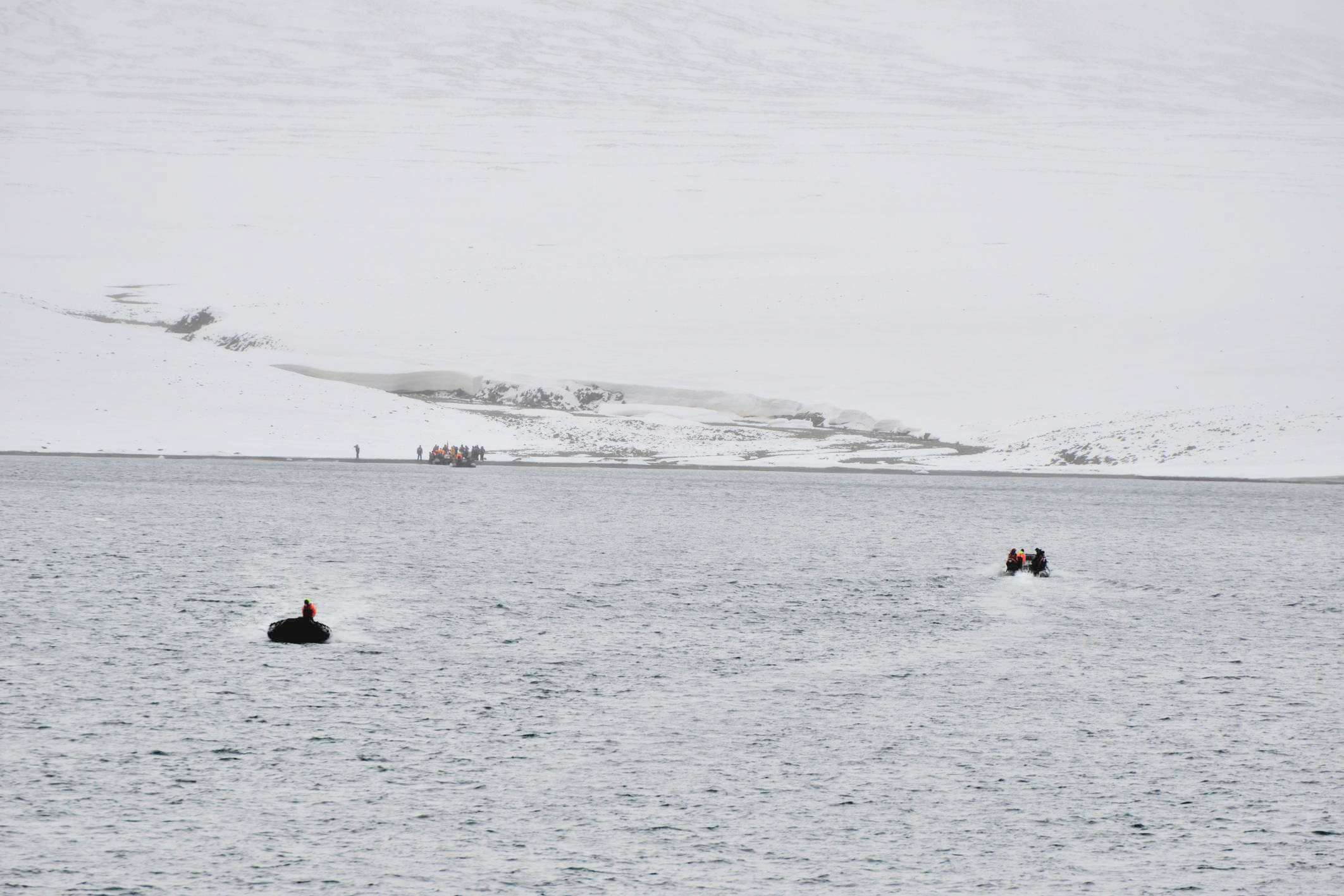|
Krenkel Bay
Krenkel Bay (russian: Бухта Кренкеля, ''Bukhta Krenkelya''), is a bay in Severnaya Zemlya, Krasnoyarsk Krai, Russia.GoogleEarth History This bay was discovered by the 1930–1932 expedition to the archipelago led by Georgy Ushakov and Nikolay Urvantsev. Decades later, in 1973, this bay was named after Soviet Arctic explorer and radio operator Ernst Krenkel (1903–1971). Geography Krenkel Bay is a body of water in the northeastern area of Komsomolets Island, the northernmost island of Severnaya Zemlya. The bay is open to the southeast. It is regular in shape and has a width of about . The edge of the massive Academy of Sciences Glacier runs all along the western shore, while the northern shoreline is bound by a stretch of unglaciated area. Ozerny Island lies close to the northeastern headland of the bay. See also *List of fjords of Russia This is a list of the most important fjords of the Russian Federation. Fjords In spite of the vastness of the Arctic coastlin ... [...More Info...] [...Related Items...] OR: [Wikipedia] [Google] [Baidu] |
Landsat
The Landsat program is the longest-running enterprise for acquisition of satellite imagery of Earth. It is a joint NASA / USGS program. On 23 July 1972, the Earth Resources Technology Satellite was launched. This was eventually renamed to Landsat 1 in 1975. The most recent, Landsat 9, was launched on 27 September 2021. The instruments on the Landsat satellites have acquired millions of images. The images, archived in the United States and at Landsat receiving stations around the world, are a unique resource for global change research and applications in agriculture, cartography, geology, forestry, regional planning, surveillance and education, and can be viewed through the U.S. Geological Survey (USGS) "EarthExplorer" website. Landsat 7 data has eight spectral bands with spatial resolutions ranging from ; the temporal resolution is 16 days. Landsat images are usually divided into scenes for easy downloading. Each Landsat scene is about 115 miles long and 115 miles wide (or ... [...More Info...] [...Related Items...] OR: [Wikipedia] [Google] [Baidu] |
Nikolay Urvantsev
Nikolay Nikolayevich Urvantsev (russian: Николáй Николáевич Урвáнцев; – 20 February 1985) was a Soviet geologist and explorer. He was born in the town of Lukoyanov in the Lukoyanovsky Uyezd of the Nizhny Novgorod Governorate of the Russian Empire to the family of a merchant. He graduated from the Tomsk Engineering Institute in 1918. Urvantsev was among the discoverers of the Norilsk coal basin and Norilsk copper-nickel ore region in 1919-1922 and was among the founders of Norilsk town. Overview Career In 1922, while leading a geological expedition, Urvantsev found evidence of the mysteriously disappeared Amundsen's 1918 Arctic expedition crew members Peter Tessem and Paul Knutsen. Urvantsev recovered the mail and scientific data that the two ill-fated Norwegians had been carrying. The valuable documents were lying abandoned on the Kara Sea shore near the mouth of the Zeledeyeva River.William Barr, ''The Last Journey of Peter Tessem and Paul Knut ... [...More Info...] [...Related Items...] OR: [Wikipedia] [Google] [Baidu] |
List Of Fjords Of Russia
This is a list of the most important fjords of the Russian Federation. Fjords In spite of the vastness of the Arctic coastlines of the Russian Federation there are relatively few fjords in Russia. Fjords are circumscribed to certain areas only; over thirty are in Novaya Zemlya —including lakes which are structurally fjords, with a few others in the Barents Sea coast of the Kola Peninsula, the Severnaya Zemlya archipelago, the Bering Sea coast of the Chukchi Peninsula and the southeastern shores of Kamchatka. * Akhmatov Fjord, Bolshevik Island, Severnaya Zemlya * Ara Bay, Kola Peninsula * Arkhangelskaya Bay, Novaya Zemlya * Bezymyannaya Fjord, Novaya Zemlya * Blafyel Bay, Novaya Zemlya * Bolshaya Karmakulskaya, Novaya Zemlya * Bolshaya Volokovaya, Kola Peninsula * Borzov Bay, Novaya Zemlya * Brandt Bay, Novaya Zemlya''Prostar Sailing Directions 2005 North Coast of Russia Enroute'', p. 77 * Chekin Bay, Novaya Zemlya''Prostar Sailing Directions 2005 North Coast of Ru ... [...More Info...] [...Related Items...] OR: [Wikipedia] [Google] [Baidu] |
Unglaciated
A glacier (; ) is a persistent body of dense ice that is constantly moving under its own weight. A glacier forms where the accumulation of snow exceeds its ablation over many years, often centuries. It acquires distinguishing features, such as crevasses and seracs, as it slowly flows and deforms under stresses induced by its weight. As it moves, it abrades rock and debris from its substrate to create landforms such as cirques, moraines, or fjords. Although a glacier may flow into a body of water, it forms only on land and is distinct from the much thinner sea ice and lake ice that form on the surface of bodies of water. On Earth, 99% of glacial ice is contained within vast ice sheets (also known as "continental glaciers") in the polar regions, but glaciers may be found in mountain ranges on every continent other than the Australian mainland, including Oceania's high-latitude oceanic island countries such as New Zealand. Between latitudes 35°N and 35°S, glaciers occur only in ... [...More Info...] [...Related Items...] OR: [Wikipedia] [Google] [Baidu] |
Academy Of Sciences Glacier
The Academy of Sciences Glacier (russian: ледник Академии наук; ''Lednik Akademii Nauk''), is a large ice cap on Komsomolets Island, Severnaya Zemlya, Russian Federation. It is the largest in Severnaya Zemlya and is also the largest single glacier formation of Russia. History This glacier was named after the Soviet Academy of Sciences by the 1930–1932 expedition to the archipelago led by Georgy Ushakov and Nikolay Urvantsev. A long ice core was drilled between 1999 and 2001 from a drilling site located near the summit of the Academy of Sciences Glacier. Geography The Academy of Sciences Glacier is roughly circular in shape with a diameter of about and an area of . It covers almost two thirds of Komsomolets island, except for an unglaciated area at the northern end. Its average height is with a maximum elevation of .Комсомолец // Словарь современных географических названий / Рус. геогр. о-во. М� ... [...More Info...] [...Related Items...] OR: [Wikipedia] [Google] [Baidu] |
Ernst Krenkel
Ernst Teodorovich Krenkel (russian: Эрнст Теодо́рович Кре́нкель; in Białystok – 8 December 1971 in Moscow) was a Soviet Arctic explorer, radio operator, doctor of geographical sciences (1938), and Hero of the Soviet Union (1938). Amateur radio callsigns: U3AA, UA3AA, RAEM. Early life Krenkel was born in Białystok, now Poland, to a German family. Career Ernst Krenkel was a radioman on polar stations * ''Matochkin Shar'' at Novaya Zemlya (1924–1925, 1927–1928), * ''Tikhaya Bay'' at Franz Josef Land (1929–1930), * ''Cape Olovyanniy'' at Severnaya Zemlya (1935–1936), and * ''Domashniy Island'' at Severnaya Zemlya (1936). He took part in Arctic expeditions on the '' Graf Zeppelin'' airship (1931), icebreaker '' Sibiryakov'', steamship (1933–1934, callsign RAEM). He was also a radioman on the first drifting ice station ''North Pole-1'' (1937-1938, callsign UPOL). He is known to have set a world record in January 1930 by establishing a lo ... [...More Info...] [...Related Items...] OR: [Wikipedia] [Google] [Baidu] |
Arctic Explorer
Arctic exploration is the physical exploration of the Arctic region of the Earth. It refers to the historical period during which mankind has explored the region north of the Arctic Circle. Historical records suggest that humankind have explored the northern extremes since 325 BC, when the ancient Greek sailor Pytheas reached a frozen sea while attempting to find a source of the metal tin. Dangerous oceans and poor weather conditions often fetter explorers attempting to reach polar regions and journeying through these perils by sight, boat, and foot has proven difficult. Ancient history Indo-European Hypothesis A controversial hypothesis, often regarded as pseudohistory, sets the home of the mythical people Hyperboreans in the Arctic. The scientist and author John G. Bennett talked about it in his research paper "The Hyperborean Origin of the Indo-European Culture" (1963). The theory was originally put forth by William F. Warren, the first President of Boston University, in h ... [...More Info...] [...Related Items...] OR: [Wikipedia] [Google] [Baidu] |
Georgy Ushakov
Georgy Alexeyevich Ushakov (russian: Георгий Алексеевич Ушаков) (17 (30) January 1901 – 3 December 1963) was a Soviet explorer of the Arctic. Ushakov broke new ground when he surveyed and explored Severnaya Zemlya, together with four other Arctic explorers, establishing that it was an archipelago. He was honoured by being named Doctor of Geographic Sciences in 1950. Career In 1926, Ushakov founded the first Soviet settlement on Wrangel Island (today called Ushakovsky) and was its head for three years. In 1930–1932, Ushakov headed the Severnaya Zemlya expedition and established a polar station called ''Остров Домашний'' (Domashniy Island). at Polar World. In 1929 and 1930 icebreaker [...More Info...] [...Related Items...] OR: [Wikipedia] [Google] [Baidu] |
Krasnoyarsk Krai
Krasnoyarsk Krai ( rus, Красноя́рский край, r=Krasnoyarskiy kray, p=krəsnɐˈjarskʲɪj ˈkraj) is a federal subject of Russia (a krai), with its administrative center in the city of Krasnoyarsk, the third-largest city in Siberia (after Novosibirsk and Omsk). Comprising half of the Siberian Federal District, Krasnoyarsk Krai is the largest krai in the Russian Federation, the second largest federal subject (after neighboring Sakha) and the third largest subnational governing body by area in the world, after Sakha and the Australian state of Western Australia. The krai covers an area of , which is nearly one quarter the size of the entire country of Canada (the next-largest country in the world after Russia), constituting roughly 13% of the Russian Federation's total area and containing a population of 2,828,187 (more than a third of them in the city of Krasnoyarsk), or just under 2% of its population, per the 2010 Census. Geography The krai lies in the middl ... [...More Info...] [...Related Items...] OR: [Wikipedia] [Google] [Baidu] |
GoogleEarth
Google Earth is a computer program that renders a 3D representation of Earth based primarily on satellite imagery. The program maps the Earth by superimposing satellite images, aerial photography, and GIS data onto a 3D globe, allowing users to see cities and landscapes from various angles. Users can explore the globe by entering addresses and coordinates, or by using a keyboard or mouse. The program can also be downloaded on a smartphone or tablet, using a touch screen or stylus to navigate. Users may use the program to add their own data using Keyhole Markup Language and upload them through various sources, such as forums or blogs. Google Earth is able to show various kinds of images overlaid on the surface of the earth and is also a Web Map Service client. In 2019, Google has revealed that Google Earth now covers more than 97 percent of the world, and has captured 10 million miles of Street View imagery. In addition to Earth navigation, Google Earth provides a series of ... [...More Info...] [...Related Items...] OR: [Wikipedia] [Google] [Baidu] |
Ozerny Island
Ozyorny (masculine), Ozyornaya (feminine), Ozyornoye (neuter), or Ozyornye (plural for all genders) may refer to: *Ozyorny (inhabited locality) (''Ozerny'', ''Ozyornaya'', ''Ozyornoye''), name of several inhabited localities in Russia *Ozyornaya (Moscow Metro), a metro station in Moscow, Russia. *Ozyornaya railway station, a railway station in Saint Peterburg, Russia *Ozerne (air base) Ozerne is an air base of the Ukrainian Air Force located near Ozerne, Zhytomyr Oblast, Ukraine. The base is home to the 39th Tactical Aviation Brigade flying Sukhoi Su-27UB and Aero L-39C Albatross aircraft. Ozerne (, given in source materi ..., an air base in Zhytomyr Oblast, Ukraine See also * Ozyornye, a village in Kirov Oblast, Russia * Ozerne (other) {{Disambiguation ... [...More Info...] [...Related Items...] OR: [Wikipedia] [Google] [Baidu] |






